Few things will make your dog happier and your life easier than a big, fenced-in yard. But because many dogs are escape artists, you must be sure to select a fence that will keep your canine contained.
While there is no perfect fencing solution that will work for all dogs, there are a few options on the market that will likely keep your dog safe. We’ll talk about some of the best fencing options, materials, and styles below. We’ll even discuss the primary ways dogs escape – because knowledge is power!
But first, let’s talk about a few of the reasons your dog deserves a fenced yard.
Types of Outdoor Fence Materials For Canine Containment
There are a number of different types of fences on the market and they are made from a wide variety of materials. But only a few styles and materials will work well for dog-occupied yards.
Some traditional fences are primarily designed to be decorative, and others lack the strength or security to keep your canine contained.
From a dog owner’s perspective, there are five basic options, which we’ve arranged in the approximate order of the security they provide:
1. Picket Fences
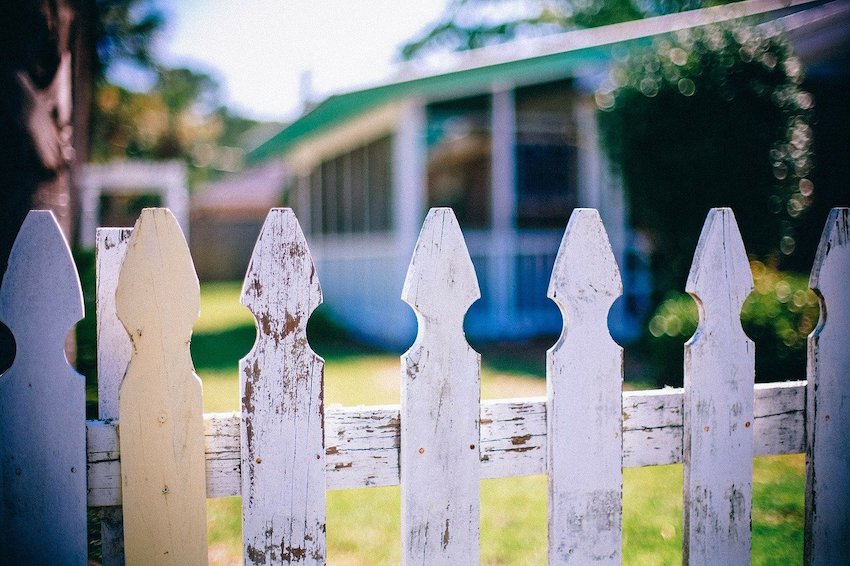
Picket fences are generally rather short, and they have moderately large gaps between the slats. They may also feature scalloped tops or decorative post caps.
They’re usually employed for aesthetic purposes, to keep those darn kids off your lawn, or reminding neighbors that you have indeed achieved the “American Dream,” rather than for security or privacy.
Picket fences have traditionally been made from wood, but you can also purchase prefabricated sections made from other materials, including vinyl and PVC.
Wooden versions can be painted any color of the rainbow, but the other varieties usually come pre-dyed in a few common, relatively neutral colors.
A picket fence may keep more easy-going and laid-back dogs contained, but it won’t do much against medium-sized dogs like labs, boxers, or golden retrievers who really want to escape. It won’t even slow them down – they’ll simply jump right over the top. Or, alternatively, chew through the slats. Even small, athletic dogs like Jack Russel terriers could probably leap over them in a single bound.
You don’t want to rely on a picket fence to keep unattended dogs contained (and truthfully, you should never leave a dog outside unsupervised anyway), but it may allow your tiny toy dog to hang out with you while you’re doing yard work or chilling on the porch with an adult beverage.
2. Wide-Gap Metal Fences
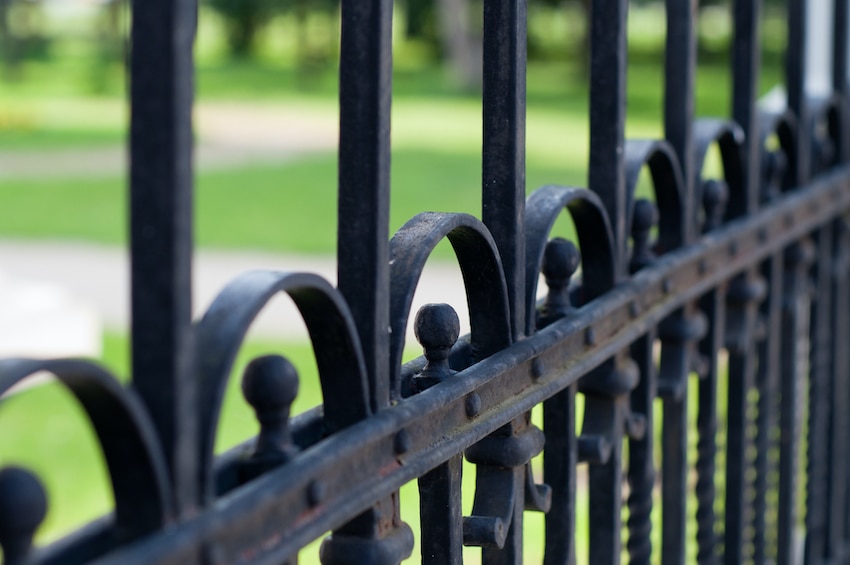
Wide-gap metal fences are usually comprised of a series of vertical metal poles and a pair of horizontal connecting rods (sometimes called pickets and rails, respectively) at the top and the bottom.
They are sold in 6- or 8-foot-long sections, in heights ranging from 3 to 6 feet tall.
The poles may be round or square, and they are usually made from wrought iron or aluminum. Wrought iron is incredibly strong, but it is expensive and will rust over time. Aluminum is cheaper than wrought iron and won’t rust, but it isn’t as strong.
Aluminum is, however, much lighter and therefore easier to install yourself.
The gaps between the poles of most wrought iron and aluminum fences are between 3- and 4-inches-wide, but you may find fences with larger or smaller gaps than this. Just be sure the gaps are narrow enough to prevent your dog’s head from slipping through, and it should keep him contained.
Really athletic dogs may be able to jump over these fences, but they’re pretty tough to climb. They’re probably best suited for medium to large dogs who aren’t great leapers.
3. Chain-Link Fences
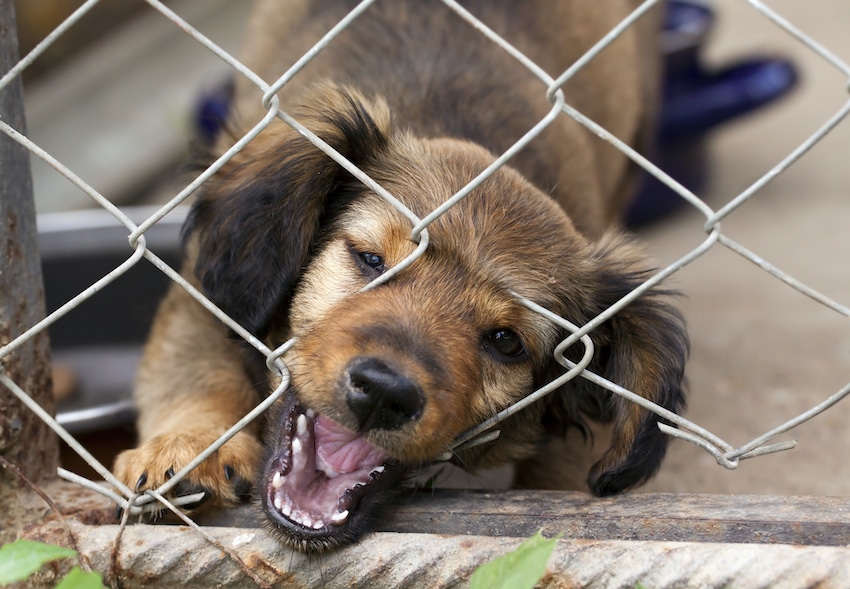
Chain-link fences are made from a series of steel poles and a long sheet of galvanized steel wire, which is attached to the poles for support.
The tallest versions available in most consumer-level retail outlets are about 6 feet, but you can find 8-, 10-, or 12-foot-tall options at fence supply companies. Some chain-link fences are coated with colored vinyl.
Chain-link fences are one of the more affordable options, and they’re extremely durable. They don’t look great, nor do they provide any privacy, but they are a cost-effective option that is especially well-suited for large properties. Chain-link fences are also relatively easy to install, even on uneven terrain.
Some dogs can climb or jump over chain-link fences, so taller versions (those over 6 feet tall) are considerably more secure than shorter fences.
Some dogs may be able to chew through the connecting wires and break through these fences too, but this is typically only a problem with the most determined escape artists.
4. Privacy or Solid Fences
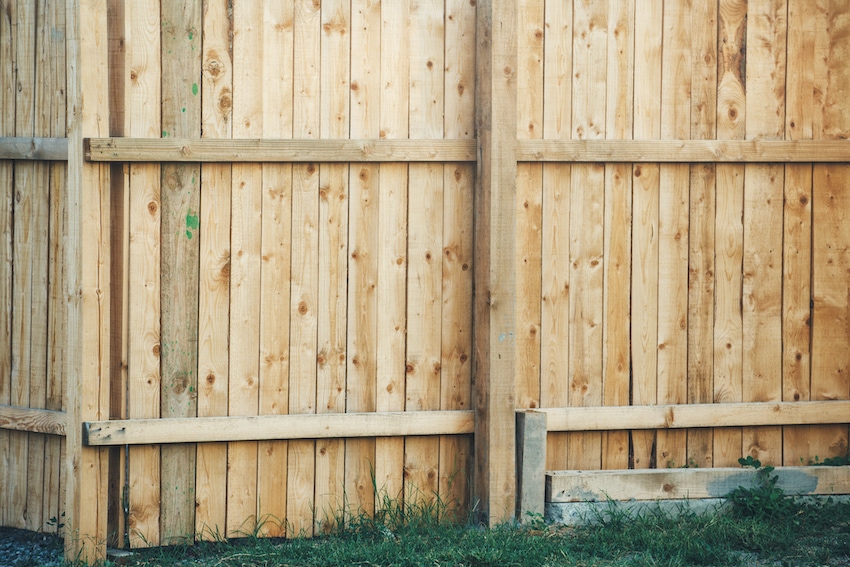
Privacy fences (which are sometimes called shadow box fences) are usually constructed from wood, but they can also be made from PVC, vinyl, or other materials.
Wood is generally the most affordable option, while those made from plastics or composites can be more pricey but usually require less maintenance.
Privacy fences are generally rather tall (they are often more than 6 feet high) and their slats sit directly in contact with each other, leaving no or only very small gaps.
Some dogs may be able to climb over them, but they aren’t as easy to climb as chain-link fences. They should provide plenty of security for most standard non-escape-artist dogs.
They’re probably too tall for most dogs to leap over, but use caution when trying to contain dogs who are world-class jumpers.
Privacy fences are probably best suited for reactive dogs or canines who get excited when they see pets or people on the other side, as they’ll help limit this type of visual stimulation by blocking the dog’s view. Privacy fences also feature more secure corners than many other types of fences, as no gaps are present.
Privacy fences tend to be particularly popular in more urban areas, where residents desire a bit more privacy for themselves when they have small yards abutted right against high-traffic sidewalks.
5. Brick Fences
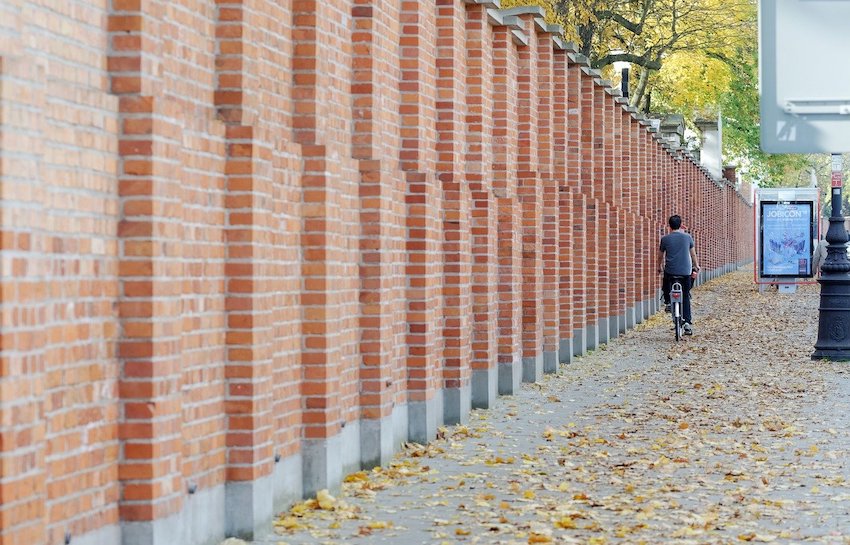
Brick fences certainly blur the line between walls and fences. However, some designs feature numerous gaps, which usually form a decorative pattern and make them somewhat fence-like.
The bricks used in the construction of these fences vary from standard red bricks to concrete blocks.
Dogs won’t be able to climb most brick fences, and you can make brick fences at whatever height you like. They’re resilient enough to contain the largest and strongest dogs, and they won’t require much maintenance over time.
The downside to brick fences is their cost. You could conceivably spend more on the materials for a large brick fence than you did on your home, so they are typically only used to enclose rather small areas. Brick fences also require considerable expertise to construct properly, which will also increase their cost.
Dog-Proof Fencing Considerations
Fences are obviously not one-size-fits-all items – you’ll have to go with a style that suits your home, your tastes, and your dog. In actuality, fences are almost always “custom built” to satisfy these and other criteria (even if they’re made from prefabricated pieces).
This means you’ll need to think carefully about a number of issues when selecting the best dog proof fence for your home. Some of the most important things to consider include:
Installation
Some fences are easier to install than others. For example, prefabricated vinyl fences are pretty easy to set up — even for those without much home improvement experience. You’ll probably want a friend or your spouse to help you with the project, but you won’t need to pay for professional installation.
On the other hand, privacy fences and some other styles will require plenty of time, effort, and expertise to install properly. If you aren’t willing to dedicate a full weekend (and maybe longer) to the project, you’ll probably be better off hiring professionals to install your fence.
Aesthetics
You’ll also want to pick a fence that appeals to your sense of style. There are no right or wrong answers here; you like what you like. However, it is wise to consider how your choice will affect the resale value of your home and be sure that you aren’t running afoul of any local codes or homeowners’ association rules.
Property Lines
To avoid conflict with your neighbors, make sure that you know exactly where your property lines are located. If your house has been surveyed recently, you may still be able to locate the property lines, but if your house has not been surveyed in the recent past, you’ll probably want to have a crew come out and identify the lines properly.
Durability
Fences represent a significant investment, and many will also require you to invest a lot of elbow grease during the installation process. Accordingly, you’ll want to consider durability when making your choice. This not only means selecting a fence made from durable materials, but also choosing one that features robust connection points.
Maintenence
Different types of fences require different types of maintenance. Some, such as chain link fences, typically won’t require any, but wooden fences may need to be repainted every few years. Others, such as wrought iron fences which will rust over time, may need to be sanded periodically.
Security
It’s obviously important to select a fence that will keep your dog safely contained. Different dogs will present different challenges in this regard, so there is no single type of fence that will work in all cases. For example, a mid-height picket fence may safely contain a small, relatively calm dog, but it wouldn’t even slow down a bigger dog, who could simply jump over it.
Cost
Cost is always a factor in the real world, so you’ll want to figure out your budget before you start trying to pick a fence. Make sure you factor in the installation and maintenance costs when making your choice.
Dog’s Demeanor
You’ll also need to take your dog’s individual demeanor into account, and this will likely have the biggest impact on what kind of outdoor dog fence you choose.
K9 of Mine’s founder Meg’s dog Remy is a 50 lb pit mix, so he’s quite strong. However, he is a total pushover when it comes to boundaries. He won’t even push open a cracked door or step over a cardboard box. For this reason, Meg was able to get by with a very simple and somewhat flimsy DIY fence made of welded wire and stakes. While the fence has some gaps at the bottom, is weak, and could be knocked over with enough force, the fence works fine to contain Remy because of his demeanor.
What kind of fence you choose will definitely be influenced a lot simply by your dog’s individual personality.
However, keep in mind that if your dog is absolutely desperate to escape your yard, there could be other issues at play. It’s not unusual for ultra-intelligent canines to spend their brainpower trying to figure out how to escape because they are so darn bored.
Try implementing brain-teasing puzzle toys, enrichment activities, and longer sniff walks into your dog’s schedule and you may find his desire to escape disappear.
Traditional Dog Fence Alternatives: Quick & Easy Options!
Traditional fences aren’t the only way to keep your dog safely contained. There are a number of other options available to dog owners, which may suit your situation well.
Modular Fences
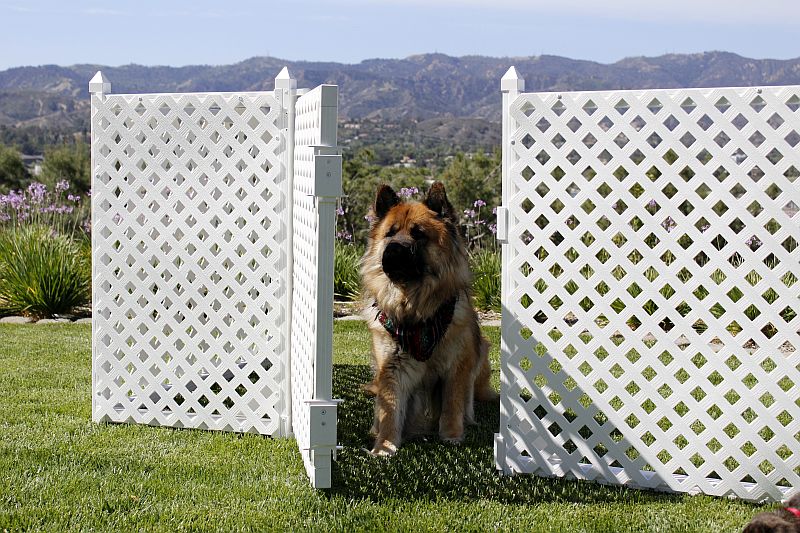
Modular fences are a great traditional fencing alternative for many owners who need to keep their canine contained.
A secure, yet non-permanent option, modular fences provide a number of the same features and benefits that traditional fences do. Specifically, they give your doggo a safe and secure outdoor space to enjoy, while helping to prevent him from running away or getting into mischief.
However, modular fences are more affordable and easier to install than most traditional fencing options are – you could likely set one up yourself in an hour or two.
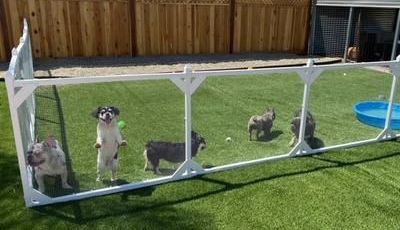
Best of all, modular fences are – by their very design – supremely flexible.
You can use them to enclose just about any space you have available, no matter the size or shape. For that matter, you can also make adjustments as your needs change or your pooch grows.
Want to enclose most of your backyard? Just need to make a little outdoor play area? Interested in installing a barrier around places you don’t want your dog to access (like your beloved flower beds)? Simply need a way to prevent your pooch from leaving the porch?
Modular fences will work for all of these applications and more.
There are a few different modular fence manufacturers around, and most are designed for a particular niche or application. This can make it hard for dog owners to know where to start, but we’ll make it easy for you: SnapFence undoubtedly makes one of the best modular fences for four-footers.
Designed to be safe and effective yet easy to customize, SnapFences are sold in two different ways: You can purchase a complete kit or you can put together a custom project by simply purchasing individual components.
We think most dog owners will be best served by sticking with the kits, but YMMV.
To get your kit on the way, you’ll start by picking out the type of fencing panels you want. Then, you’ll select the appropriate size for your dog and the space you want to enclose.
You’ll then decide on some final options, like whether or not you want a gate included with the kit.
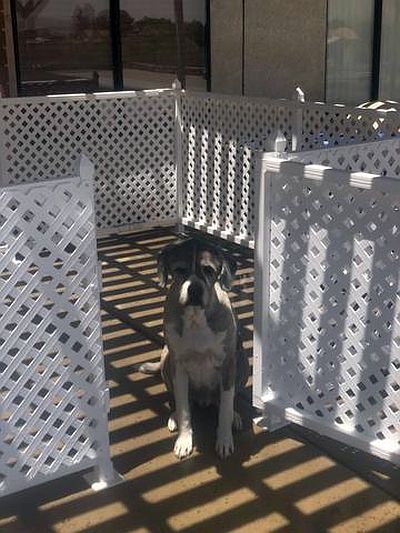
You can also tack additional parts like rails, connectors, or decorative fence caps onto your order. You’ll even have the chance to select the best type of anchors for the project, as SnapFence offers anchors that are appropriate for either hard or soft surfaces.
This is a sponsored placement, in which an advertiser pays a fee to be featured in this article. Learn more
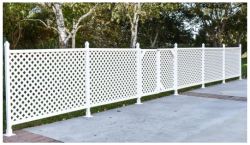
SnapFence Modular Fencing
High-quality modular fencing solutions that are easy to install, affordable, customizable, and attractive.
Some of the most notable features of SnapFence modular containment options include:
- You can choose from wire mesh or plastic lattice panels.
- They have anchor options designed for both soft and hard surfaces.
- Kits are sold in 7 different lengths, ranging from 24- to 72-feet long.
- Corner connectors are included with every fence.
- The fences offered are 3 feet tall.
- Fence posts are made from attractive, lightweight, and durable vinyl.

SnapFence offers a few other interesting products you may want to check out, such as their modular fence toppers. These are essentially short fencing sections that you mount on an existing concrete wall to make it more secure without having to start from scratch.
Pros
- A great customizable option for unusual spaces or needs
- Super easy to install
- Much more affordable than traditional fencing options
- Non-permanent solution you can alter as necessary
- Great option for renters – just take it with you when you move
Cons
- May not be suitable for escape-prone dogs who can jump higher than 36 inches.
SnapFence and other modular fences aren’t perfect solutions for all situations, but they are fantastic for small dogs, pups who need a little outdoor play space, and owners who’re trying to enclose an unusual space. They’re also great for pet parents who need a more affordable option to traditional fences.
Invisible Fences
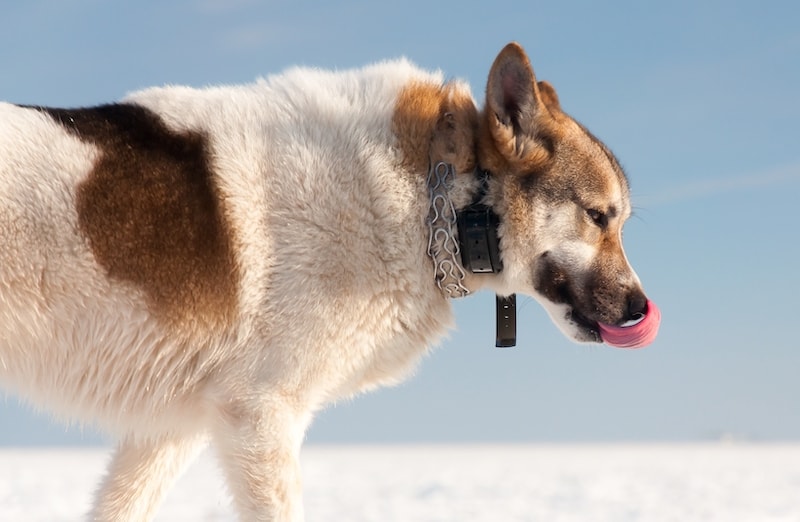
Invisible dog fences (sometimes called shock or electric fences) are an option among many owners who don’t wish to have a physical fence in their yard.
How Invisible Fences Operate
These fences come in two basic forms:
- Some include a wireless radio signal unit that emits a circular perimeter zone around your yard.
- Others include a wire-based unit that requires you to dig a trench around the perimeter of your yard (or the area you wish to enclose). The long wire will then be placed in the trench and buried.
Your dog will then be fitted with a special collar that is capable of delivering shocks of varying intensities. Small flags are often placed over the perimeter zone to help provide a visual clue to your dog and help him understand where the boundary is (the flags can usually be removed after a few weeks of training).
Most owners will likely prefer the idea of the wireless radio unit. The only problem is that radio units cannot be customized for oddly shaped yards (you’ll always have a circle for a boundary line) and large boulders or land masses can obstruct the radio’s boundary line. The upside is that wireless fences are easy to set-up and serve as great portable dog fences too that can be used on vacation or when camping.
When your dog approaches the boundary, the collar will begin delivering a mild shock. If he keeps getting closer, the strength of the shock will increase. This will discourage most dogs from crossing the boundary.
However, some dogs appear to decide that a strong shock is an acceptable price to pay for the glory of freedom, which means these fences aren’t effective for all dogs.
Invisible fences are generally best suited for dogs who aren’t incredibly inclined to wander off in the first place. The invisible fence will simply serve as a reminder about the boundaries and help prevent your pet from straying while chasing squirrels and birds.
Invisible Fence Controversy: Are They Ethical?
While invisible fences can seem like an easy solution to your pup containment problems, they are somewhat controversial.
You can read all about the pros and cons of invisible electric dog fences in our full guide, but in short, these types of fences use aversive training, relying on fear and pain to manage your dog — something many modern dog trainers discourage owners from doing.
Even if you’re not bothered by the morality of using aversive training tools, these types of fences require a significant amount of training time, as you must teach your dog where the boundary perimeter is and reinforce that boundary over the course of several weeks.
Failing to implement appropriate training can traumatize your dog. Because he won’t know why he is being shocked, he may become afraid of going outside at all. In fact, some dogs become so terrified by invisible fences that they will stay frozen in their yard without moving a muscle because they are so afraid of being shocked!
So, if you aren’t willing or able to invest the time to train your dog with an invisible fence, definitely opt for a physical fence, instead.
Leash Stakes
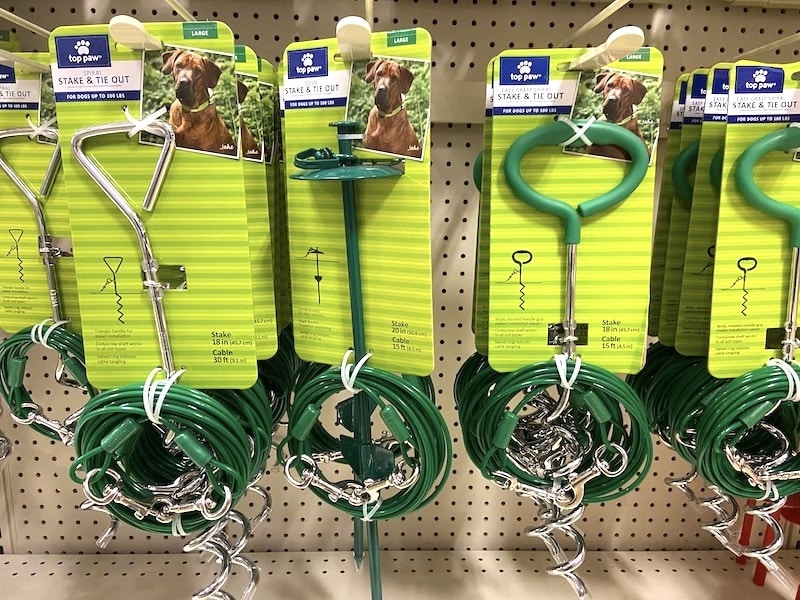
A leash stake (also known as a tie-out) is a long piece of corkscrew-shaped metal, with a large ring attached to the top.
You’ll twist the stake into the ground and then attach your dog’s leash or a long tether to it. This will keep your dog from running off while giving him a relatively large amount of area to roam.
If installed properly and used with a flexible chain rather than a rope (which your dog may be able to chew through), stakes can be relatively secure. However, they won’t prevent people or other animals from approaching your dog. Accordingly, they are still better used while you are able to supervise your pup.
Petey’s Pet Products makes a standard leash stake that will work well for most dogs. It comes in two different versions: One has a 20-foot-long lead and the other has a 30-foot lead.
This is a sponsored placement, in which an advertiser pays a fee to be featured in this article. Learn more
However, the SUREswivel 360-Degree Swiveling Pet Tie-Out may be a better choice for big or strong dogs, as it’s a tie-out capable of withstanding 1,000 pounds of pulling force.
For more leash stake options, be sure to check out our guide to the best dog tie outs and tie downs!
Dog Runs
Dog runs also keep your dog from running off via a leash or tether. They feature a long cable or wire, which is usually suspended several feet above the ground (note that some people also use the term “dog run” to refer to a long, skinny fenced area).
Your dog’s leash or tether is clipped to a sliding pulley that is connected to the cable. This allows your dog to run the length of the cable, plus the length of the leash or tether to each side.
Dog runs give your dog more room to run than stakes do, but they still present the same safety hazards, so they’re not appropriate for all situations. Also, because your dog will be running back and forth over the same stretch of your property, you may end up with bare patches on your lawn.
The Pet Champion Aerial Run is a good option that comes with a 60-foot, vinyl-covered cable, a 10-foot-long tether, and all of the hardware you’ll need. This system will allow your dog to enjoy up to 1,200 square feet of play space.
This is a sponsored placement, in which an advertiser pays a fee to be featured in this article. Learn more
Owners who know their way around the local hardware store may simply want to design their own DIY custom dog run, but you can also buy ready-to-install kits.
Outdoor Kennels or Playpens
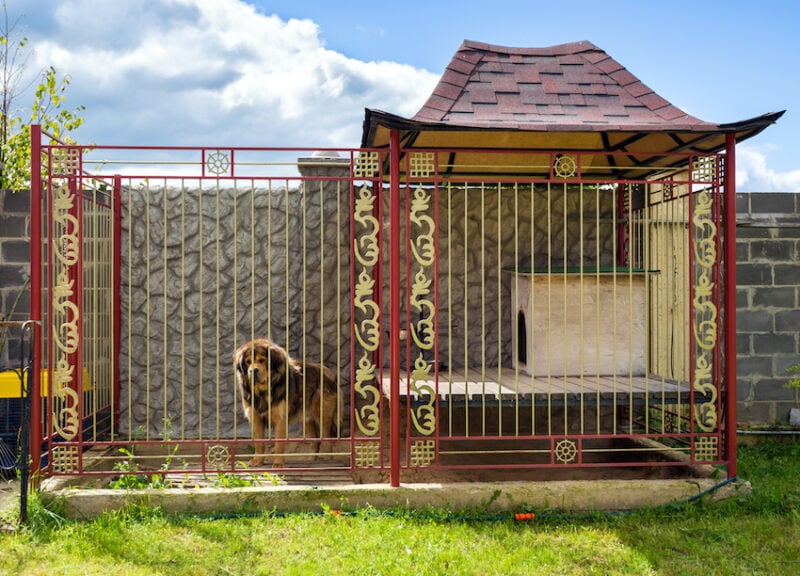
Many manufacturers make small, fenced enclosures that can simply be placed in your backyard. This eliminates the need to construct a permanent fence, and it also means that you can move the playpen or kennel around your backyard. Most of these enclosures are constructed from chain-link fencing, but there are a few other options available.
These enclosures rarely come in sizes large enough to give big dogs room to run, but they’ll usually provide little dogs with enough space to get some exercise. They are available in a variety of heights, so you can usually find one that will work for your high-jumping dog, but you will need to be careful to ensure your dog can’t crawl beneath the fence.
The Iris White Eight Panel Pet Containment Pen is a great example of an outdoor dog playpen. It is made heavy-duty plastic, so it is lightweight, yet durable, and it won’t rust when exposed to the elements. It’s only 34 inches tall, so it isn’t a great option for big dogs, but it’ll work for small breeds and dogs who aren’t inclined to jump or climb.
This is a sponsored placement, in which an advertiser pays a fee to be featured in this article. Learn more
The Advantek Pet Gazebo is a better option for large dogs, as it measures 90 inches tall (there are also smaller versions available). It is easy to set up or move, and it even comes with a cover to help protect your dog from the sun or rain. It also features a handy “window” that’ll make it easy to give your dog his favorite toy or a bowl of food without having to open the main door.
This is a sponsored placement, in which an advertiser pays a fee to be featured in this article. Learn more
If you’re considering this option, also make sure to check out our guide to outdoor dog kennels, as we discuss some larger kennel run options for folks willing to have such a structure in their yard.
How Dogs Benefit From Fenced-In Yards
There are a number of reasons fenced yards are beneficial for dogs and their owners. Some of the most important include:
Fenced yards allow your dog to get more exercise. Just like their owners, dogs need regular exercise to remain healthy, fit, and trim. A fenced yard – even a relatively small one — will give him room to run, jump, and play, and encourage him to get plenty of exercise.
Fenced yards help prevent boredom. Dogs who get the chance to chase squirrels, smell interesting things, and bark at passing pedestrians will enjoy a ton of mental stimulation (a handful of puzzle toys won’t hurt either). They’ll not only be happier when provided such opportunities, but they are less likely to become bored, which often leads to destructive behaviors.
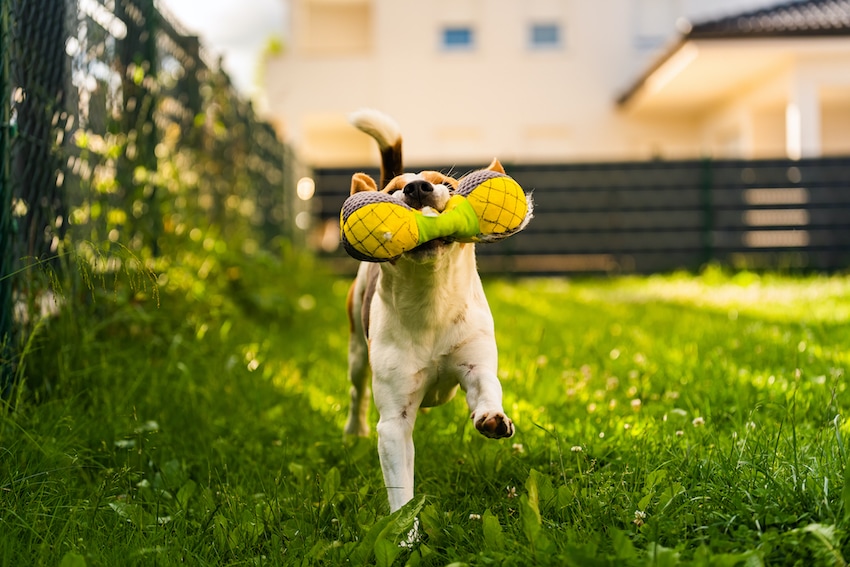
Fenced yards make bathroom breaks more convenient. Even if you have an adult dog who only needs a few poop and pee breaks each day, there will surely be times when you just don’t feel like going on a long walk to allow him to do his business. A fenced yard makes it easy to just let your dog go outside and answer nature’s call without you even having to put on your shoes or grab the leash.
Fenced yards are great for dogs who can’t go to the dog park. Many dogs have a blast at the local dog park, but some aren’t capable of playing nicely with others (I’m glaring at my own beloved, yet antagonistic, pup at the moment). Other dogs can’t go to the park for medical reasons. And while your backyard may not provide much social interaction, it’ll still allow your dog to have a bit of fun.
Fenced yards may help your dog ward off criminals. Even relatively small dogs will often bark up a storm when strangers approach, so a fenced yard may help keep your home a bit safer.
Different Ways Dogs Can Escape Fences
Different dogs tend to embrace different strategies for escaping the yard, but most employ one of the following five methods.
They may:
- Jump over the fence.
- Climb over the fence.
- Dig under the fence.
- Chew or push their way through the fence.
- Use their nose to lift the gate latch.
You’ll need to address these escape techniques in different ways.
Jumpers & Climbers
Jumpers and climbers can be thwarted relatively simply – just install a fence that is too tall for the dogs to clear.
Six to 8-foot-tall fences will suffice for most jumpers, and they will also make it harder for dogs to climb over the top. However, opting for a fence with a smooth surface will prove even more effective for containing climbers.
You can also install rollers at the top of your fence to help keep your dog from escaping. Rollers are generally made of PVC pipe, and they’re mounted around metal pipes that hold them in place. When your dog puts his front paws on the roller, it will spin toward him, thereby preventing him from getting a grip.
Diggers
Diggers can be trickier to keep sequestered in the backyard. You can put down a gravel barrier at the base of the fence, which may discourage your dog from digging holes under it.
Alternatively, you can install a fence that extends below ground level about 12 to 24 inches. This will require you to dig a trench, which will increase the labor needed, and it will also increase your materials costs, but sometimes it is the only way to safely contain dogs who like to tunnel their way to freedom.
Bustin’ Through (AKA “These Walls Shall Not Hold Me”)
Other dogs just try to bust through fences Kool-Aid-man style.
They may fling their body against the fence, try to slip their head and shoulder through gaps, or they may even gnaw at the fence until they create an opening.
Opting for super-durable materials, such as wrought iron, brick, or, in some cases, properly sealed hardwoods, will usually stop dogs from powering right through the fence.
Gate Openers
The best way to thwart gate openers is to simply add a padlock or dog-proof clip to the gate. This will prevent most dogs from liberating themselves.
Fenced Yards Won’t Replace Walks: You’ll Still Need to Take Your Dog Out Daily
A fenced yard should not serve as a replacement for daily walks – your dog still needs the chance to cruise around the neighborhood, pee in all the right spots, and enjoy a change of scenery.
You certainly don’t need to go on as many walks if you add a fence to your yard, but walks will still be an important part of your dog’s daily routine.
For example, if you normally walk your dog three times a day, a fenced yard may allow you to cut this down to a single, leisurely walk each afternoon. Just let your dog out in the backyard first thing in the morning and right before bed, and then take 20 minutes to explore the neighborhood with your pooch when you get home from work.
Have you installed a dog-proof fence around your yard? What type of fence did you select? Has it worked as well as you hoped it would? Let us know about your experiences in the comments below.
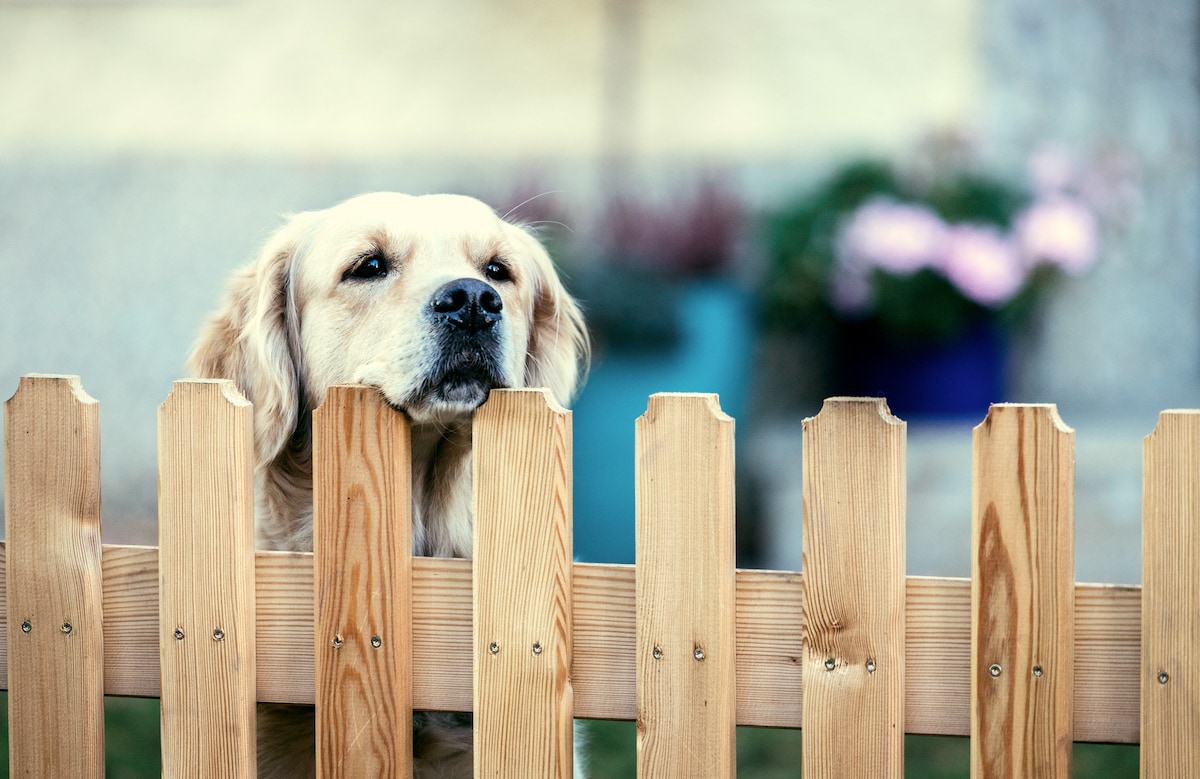


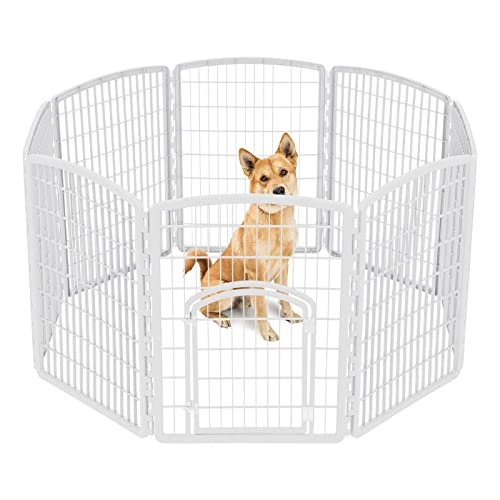




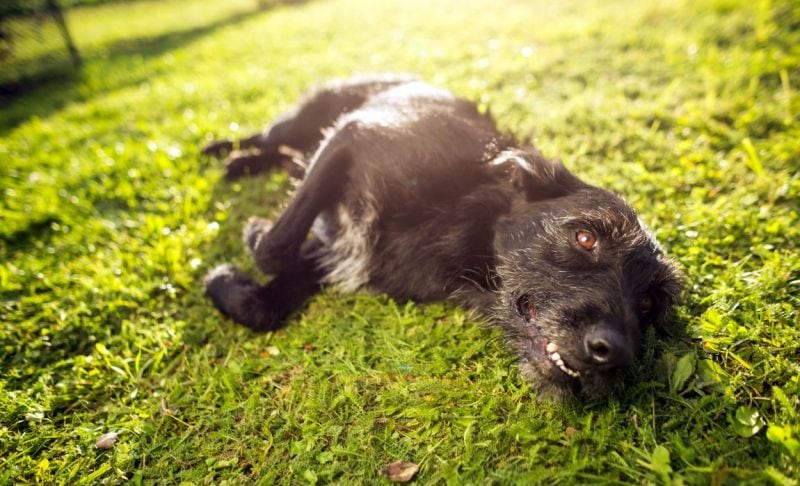
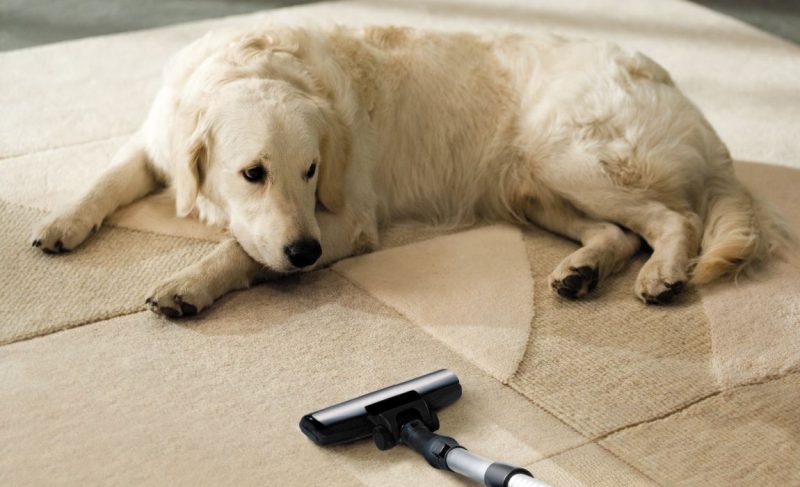


Leave a Comment